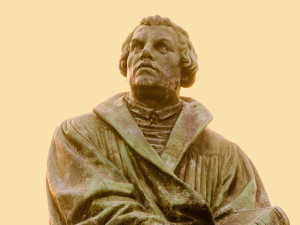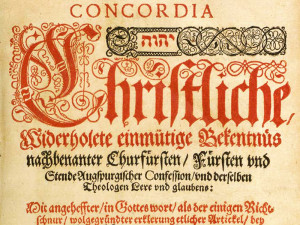by Rev. James Lee
 Historical caricatures of Martin Luther often emphasize certain dramatic moments in the life of the Augustinian friar, such as the posting of the 95 Theses, or Luther’s defense of his teaching at the Diet of Worms. While these scenes are fun to imagine and present easy factoids about Luther, they often fail to address the heart of Luther’s thought. A person might know the date of these events, perhaps even the role they played in the history of the Reformation, but that person would not necessarily understand Luther’s teaching and doctrine—what he believed was necessary to uphold and confess. In order to understand this, it is helpful to consider Luther’s 1537 Smalcald Articles, where Luther writes that the first and chief article of the Christian Church is Jesus Christ, and the doctrine of justification: “That Jesus Christ, our God and Lord, died for our sins, and was raised again for our justification.” Luther argues everything that the Church believes, confesses, and practices rest upon the Church’s confession of Jesus Christ and His work of justification.[1] Luther even goes as far as to advise the pastors of Lübeck, who are eager to correct errors and false teaching of the medieval Mass, to first give attention to Christ and justification. Luther writes,
Historical caricatures of Martin Luther often emphasize certain dramatic moments in the life of the Augustinian friar, such as the posting of the 95 Theses, or Luther’s defense of his teaching at the Diet of Worms. While these scenes are fun to imagine and present easy factoids about Luther, they often fail to address the heart of Luther’s thought. A person might know the date of these events, perhaps even the role they played in the history of the Reformation, but that person would not necessarily understand Luther’s teaching and doctrine—what he believed was necessary to uphold and confess. In order to understand this, it is helpful to consider Luther’s 1537 Smalcald Articles, where Luther writes that the first and chief article of the Christian Church is Jesus Christ, and the doctrine of justification: “That Jesus Christ, our God and Lord, died for our sins, and was raised again for our justification.” Luther argues everything that the Church believes, confesses, and practices rest upon the Church’s confession of Jesus Christ and His work of justification.[1] Luther even goes as far as to advise the pastors of Lübeck, who are eager to correct errors and false teaching of the medieval Mass, to first give attention to Christ and justification. Luther writes,
“You should deal first with the center of our teaching and fix in the people’s minds what [they must know] about our justification; that is, that it is an extrinsic righteousness— indeed, it is Christ’s given to us through faith which come by grace to those who are first terrified by the law and who, struck by the consciousness of [their] sins ardently seek redemption.”[2]
Only after people have been instructed in the central article of Christ and justification, is any true reform possible.
Luther’s words to the clergy of Lübeck suggest an ordering and connection of the articles of faith. The life and essence of the Christian Church is found in Jesus Christ and His work of justification. The Reformation scholar and Lutheran theologian Robert Preus summarizes Luther in this manner:
“According to Luther, then, the justification of a sinner before God for Christ’s sake is not only the principal doctrine of Christianity, but also the very essence of it. Furthermore, it is really the essence of the gospel itself and of all Christian faith, the Leitmotiv of the Christian life and the reason for all that exists. It is the only doctrine or message which can offer a poor sinner hope, salvation, and life and fellowship with God.”[3]
Thus for Luther the confession of the person and work of Jesus Christ—His justification of sinful humanity—forms the heart of theology, and informs all of the Church’s confession and practice: it is the heart of the Church and it helps to shape and order the confession of the Church.
The centrality of the confession of Jesus and His work and its relationship to the whole of the Church’s confession is not simply an quirk of Luther’s own thought, but it becomes a hallmark of the Lutheran Church. In fact, the interrelationship of the person and work of Christ to the entirety of the Church’s confession shapes and structures the preeminent Lutheran text, the 1530 Augsburg Confession.
 The Augsburg Confession begins with two preliminary articles on the Triune God and the nature of original sin (A.C. I and II). From here Philip Melanchthon, the author of the Augsburg Confession, directly moves to the person of Jesus Christ (Article III: Of the Son of God) and Christ’s proper salvific work (Article IV: Of Justification). At the forefront of the Augsburg Confession is a dual profession of faith in the person and work of Christ: “they teach that men cannot be justified before God by their own strength, merits, or works, but are freely justified for Christ’s sake, through faith. . . This faith God imputes for righteousness in His sight.”[4] Christ and the salvation won by Him are front and center in the Augsburg Confession. The Reformers see that there is an integral relationship between who Christ is and the work that He accomplishes. The Church’s confession follows this pairing of Christology and justification. To confess Christ also means to confess His justifying work.
The Augsburg Confession begins with two preliminary articles on the Triune God and the nature of original sin (A.C. I and II). From here Philip Melanchthon, the author of the Augsburg Confession, directly moves to the person of Jesus Christ (Article III: Of the Son of God) and Christ’s proper salvific work (Article IV: Of Justification). At the forefront of the Augsburg Confession is a dual profession of faith in the person and work of Christ: “they teach that men cannot be justified before God by their own strength, merits, or works, but are freely justified for Christ’s sake, through faith. . . This faith God imputes for righteousness in His sight.”[4] Christ and the salvation won by Him are front and center in the Augsburg Confession. The Reformers see that there is an integral relationship between who Christ is and the work that He accomplishes. The Church’s confession follows this pairing of Christology and justification. To confess Christ also means to confess His justifying work.
Christology and justification go together—but the Augsburg Confession does not end there. Melanchthon ends the articles on Christ and justification on the subject of faith, specifically the imputation of justifying faith for the sake of Christ. And here it is necessary to follow Melanchthon’s theological path. Faith is presented at the end of the discussion of Christ and justification, Melanchthon uses the subject of faith and transitions into the next article:
“That we may obtain this faith, the Ministry of Teaching the Gospel and administering the Sacraments (Latin: institutum est ministerium docendi evangelii et porrigendi sacramenta; German: hat Gott das Predigtmant eingesezt, Evangelium und Sakramente gegeben) was instituted. For through the Word and Sacraments, as through instruments, the Holy Ghost is given, who works faith.”[5]
For Melanchthon and his fellow confessors of the Augsburg Confession the articles of Christology and justification are connected to the article on the Holy Ministry—and its points of connection are Christ and faith. Jesus is the one who has established the holy Office, and Christ has instituted this office for the purpose of faith; that is, the Holy Ministry is the means that Jesus uses to create faith through the preaching of His Word and the administration of His holy sacraments. This purpose is evident in the German term used for the office: das Predigtamt (the preaching office).
 The ordering and connection of the articles of faith that was seen in Luther is also present in the Augsburg Confession. The Augustana is not arranged in a haphazard or arbitrary manner. On the contrary, Melanchthon presents a unified confession of Christ, justification, faith, and the Office of the Ministry. Order is important: Jesus is first. Christ and His justifying work are always chief. It is Christ who justifies. To Christ and His work is joined the Office of the Ministry, as the means through which this faith in Christ and His life-giving work is distributed. The Office of the Ministry—through the preaching of the Word and the administration of the Sacraments— is the tool that God uses to bring one into the relationship of faith in Jesus Christ.
The ordering and connection of the articles of faith that was seen in Luther is also present in the Augsburg Confession. The Augustana is not arranged in a haphazard or arbitrary manner. On the contrary, Melanchthon presents a unified confession of Christ, justification, faith, and the Office of the Ministry. Order is important: Jesus is first. Christ and His justifying work are always chief. It is Christ who justifies. To Christ and His work is joined the Office of the Ministry, as the means through which this faith in Christ and His life-giving work is distributed. The Office of the Ministry—through the preaching of the Word and the administration of the Sacraments— is the tool that God uses to bring one into the relationship of faith in Jesus Christ.
The ordering of articles III, IV, and V in the Augsburg Confession is not immaterial. Our Lutheran Confessions and our Lutheran Fathers confessed Christology, justification, and the Office of the Ministry together. To be Lutheran, to join in confessing the Augsburg Confession, thus means to participate in jointly understanding and confessing together Christ, His work, and His Holy Ministry.
The Reverend James Ambrose Lee II is the assistant pastor of Trinity Lutheran Church, Worden, IL and doctoral candidate at Saint Louis University.
[1] SA II, 1.
[2] Luther, To Some Pastors of the City of Lübeck, LW 49: 261–62.
[3] Robert D. Preus, “Luther: Word, Doctrine, and Confession,” Concordia Theological Quarterly 60:3 (July 1996):175–228, 188.
[4] A.C. IV.
[5] A.C. V.
